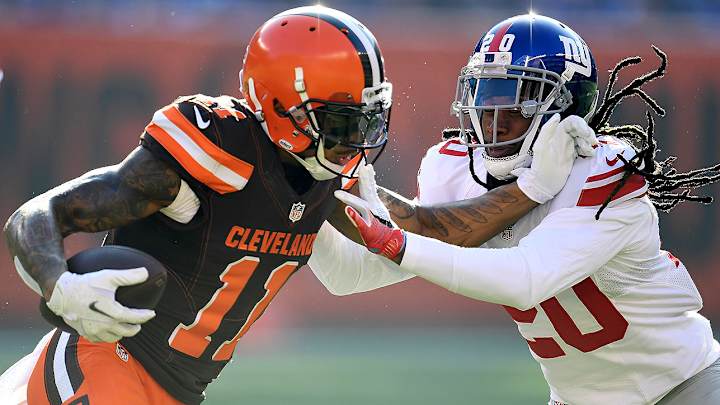Off-season report card: Washington Redskins

Last Year: 8-7-1, third in NFC East
Significant Additions: WR Terrelle Pryor (FA), LB Stacy McGee (FA), LB Terrell McClain (FA), S D.J. Swearinger (FA), DL Jonathan Allen (R1), DE Ryan Anderson (R2), CB Fabian Moreau (R3), RB Samaje Perine (R4)
Significant Departures: GM Scot McCloughan, DC Joe Barry, WR DeSean Jackson, WR Pierre Garçon
Things are still messy, but at least Washington got QB Kirk Cousins back for at least another year. Cousins’s experience in Jay Gruden’s offense is important. This year, that offense will be getting the ball to a pair of new receivers: ex-Brown Terrelle Pryor and last year’s first-rounder Josh Doctson, who has played only 31 NFL snaps because of injury. Collectively, Pryor and Doctson might be an upgrade in talent over predecessors DeSean Jackson (now a Buc) and Pierre Garçon (now a Niner), but in Gruden’s scheme, diversity at wide receiver is important. With so many of its route designs intertwined, it’s imperative to have someone who can lift the coverage deep (that was Jackson) and threaten it inside (that was Garçon). Pryor drastically improved his route-running last season in Cleveland; it’s vital he continue on that trajectory. What Doctson can do remains to be seen.
Most likely, Washington will have to rely on getting better balance from its ground game. Rob Kelley is now The Guy. Samaje Perine was drafted in the fourth round as a rotational piece; it won’t be long before he formally captures Matt Jones’s roster spot.
NFL Power Rankings, Pt. 2: Who’ll Challenge the Pats?
Defense is where this team needed the most help. Gruden fired coordinator and friend Joe Barry and replaced him in-house with linebackers coach Greg Manusky. When Manusky coordinated the Colts defense (2012–15) he ran a diverse, pressure-heavy scheme. But that was likely a function of head coach Chuck Pagano’s desires. In Washington, expect Manusky to take more of the straight coverage-based approach that Barry took. Under Barry, it was a lot of zone coverage early in the season, with increased doses of man-to-man down the stretch.
If you’re a straight coverage-based defense, you need dynamic pass rushers. Defensive backs can’t be expected to hold their coverage for more than 3.0 seconds (and 2.5 seconds if it’s a Cover 2-type zone coverage). Washington knows this. And so it was no surprise when they drafted Alabama’s Jonathan Allen in the first round and Ryan Anderson in the second. Mock drafts had Allen listed as a defensive end, but he’ll almost certainly play tackle in nickel, which is the defensive package of choice over 60 percent of the time. The selection of Anderson, a purer edge guy who weighs about 30 pounds less than Allen, only verifies this. He’ll play opposite Ryan Kerrigan. Remember, Junior Galette was originally supposed to fill this role, but he’s missed the last two years with Achilles injuries. Anything he provides this season will be bonus.
The rookies aren’t the only newcomers up front. Underrated ex-Raider Stacy McGee has a good mix of brute strength and agility, particularly in his upper-body movement. He’ll help on first and second downs. So will Ex-Cowboy Terrell McClain, another big guy who moves better than you’d guess.
OTAs news roundup: Banged up top-10 receivers and Robert Nkemdiche's big summer
These new front-seven acquisitions present more freedom for how the team can use 2014 second-round pick Trent Murphy and ’15 second-rounder Preston Smith. Murphy, who is suspended for the first quarter of this season, has toggled at different positions up front. Smith has been a little steadier, playing mostly outside. However, he doesn’t quite have the mix of explosiveness and elasticity to be a true edge-bender. (If he did, Washington would not have drafted Anderson.) Smith’s best role—and Murphy’s, too, for that matter—is as a hybrid joker on passing downs. Have him rove around the formation.
It’ll be interesting to see if either can play strong-side linebacker in a base 4–3. Both have the bodies for it. The question will be coverage. Whoever is at strong-side linebacker will play alongside Bills free agent Zach Brown, a gifted chaser but up-and-down field-reader.
Washington’s defense has more personnel options up front, and also in the secondary. That doesn’t mean there are great options, though. The third-round selection of Fabian Moreau presents even more depth at cornerback; the team will be fine there. The question is at safety. There are a bunch of strong safeties on the roster but no reliable free safeties. The hope is that D.J. Swearinger, signed from Arizona, can fill the role. He hasn’t always been the most disciplined, but to his credit, he matured tremendously with the Cardinals, and their staff felt he would have been an adequate centerfielder. Still, Swearinger is at his best in the box. Those duties, however, will likely be handled by last year’s second-rounder, Su’a Cravens. Behind Swearinger, there are more options, but none that are great. DeAngelo Hall, 33 and coming off his third major injury in as many years (this time an ACL), can’t be counted on. Will Blackmon, a converted corner, was up-and-down at safety last year. Montae Nicholson, the fourth-round rookie, will get a look.
